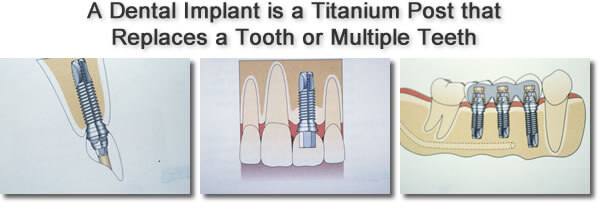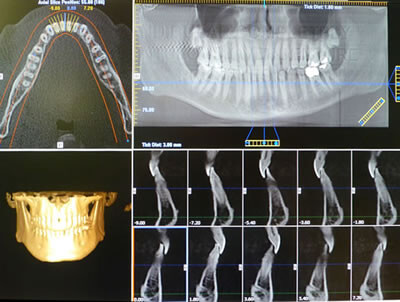Dental Implants Overview
What is a Dental Implant?
A dental implant is a titanium post that is surgically placed in the jaw to replace one, or multiple missing teeth. Implants can replace a single tooth, multiple teeth, or often times are use to replace all missing teeth. Dental implants are used to replace teeth lost from tooth decay, periodontal (gum) disease or trauma.

What material is used to construct Dental Implants?
Dental Implants are made from titanium and metal that is totally compatible with the body. Titanium is the metal of choice for artificial hip and knee replacements.
What Advantages do Dental Implants offer? Implants offer many advantages, including:
- Improved Appearance — When a natural tooth is lost, some of the bone that supported the tooth is lost as well. Placing an implant in this space helps to stabilize the bone through osseointegration, preventing its loss. By preventing bone loss, the implant helps to maintain the jawbone's shape. The gums, cheeks and lips are therefore supported as well and a natural looking smile is preserved.
- Improved Speech — Many denture wearers have difficulty with speech due to the bulk of denture resin material. Dentures may also slip during function making speech difficult. Dental implants provide anchorage for your new prosthesis so that it will not slip.
- Improved Comfort — Conventional dentures and partial dentures rest on teeth and gum tissue. Implant-supported prostheses gain support from the implants thus reducing the load to remaining teeth and gums. In turn, denture sore spots that typically occur with conventional dentures are eliminated.
- Improved Chewing Ability — Conventional dentures move away from the gums or slide during chewing, which makes eating difficult. Denture adhesives are often used to keep the dentures from moving. Implant-retained prostheses are stable, allowing you to eat with confidence and without pain or the need for adhesives.
- Improved Self-Esteem — Dentures can make a person look and feel older than they really are. Dental implants can help you chew, speak, smile and look completely natural. This functionality imparts physical, social and psychological well-being as well as a renewed self-confidence.
- Improved Oral Health — When tooth-supported bridges are made to replace missing teeth, the natural teeth that support the bridge must be "cut down" so that crowns can be made for them. Once the bridge is in use, flossing becomes more difficult because all of the crowns of the bridge are attached to each other. Further decay or periodontal (gum) disease of the supporting teeth may lead to the replacement or total loss of the bridge. Alternatively, when implants are used to replace missing teeth, adjacent teeth are not cut down thereby preserving natural tooth structure. Because the implants are not natural, they cannot decay.
- Maintenance of Jawbone Volume and Density — Jawbone needs stimulation to maintain its volume and density. It gets this stimulation when we chew. When a tooth is lost, the lack of stimulation from chewing causes a loss of bone. A 25% loss of bone at an extraction site is possible in the first year following tooth loss. More bone may be lost in subsequent years. The more teeth are lost, the more function is lost. This can lead to aesthetic and functional problems for the patient. Bone needs stimulation to stay healthy. Because implants fuse to bone, they stabilize it and prevent further bone loss. Therefore, implants must be considered as a primary replacement of missing teeth.
- Longevity — Dental Implants now have a very high overall success rate. With proper oral hygiene, many implants will last a lifetime.
Are there any Disadvantages to having Dental Implants Placed? The disadvantages to implant placement are few. They include:
- Surgery — An in-office surgical procedure is necessary for implant placement. A healing period is usually necessary before a crown, bridge, or removable prosthesis can be made.
- Cost — Dental implant procedures may incur an increase in cost when compared to conventional dentistry.
- Mechanical Failure — The fracture of abutment screws or the loosening of screws can occur. As is the case with tooth-supported crowns and bridges, the fracture of porcelain can also occur. The reported occurrence of these failures is less than 5%.
Are you a Candidate for Dental Implants? A proper diagnosis must be made before an implant can be placed. The best candidate for an implant is in good general and oral health. There must be healthy gums and an adequate amount of bone to support the implant. The patient must also be committed to good oral hygiene and regular dental visits. Implant placement in children is usually deferred until jaw growth is complete unless the implant is part of the orthodontic treatment plan.
Are there any Contraindications to having a Dental Implant placed? Behaviors such as heavy drinking and smoking can affect the success of an implant. Bruxism (tooth grinding or clenching) may not only reduce the prognosis for successful implant treatment initially but for the life of the patient as well. A custom-made bruxism appliance worn at bedtime can help minimize the forces of bruxism.
Examination Appointment for Dental Implants
The Examination Appointment for dental implants is the first step in the treatment for any patient and, sets the stage for successful completion of the entire process. A patient's medical health, oral health and X-ray evaluation must be thoroughly completed before any Treatment Plan can be presented.
The Clinical Exam of the mouth reveals the health of the teeth and periodontal condition of the patient. Once the Clinical Exam is completed, the most important Dragnostic Tool available today is an X-ray machine that uses Cone Beam Computed Tomography (CBCT) commonly referred to as a CAT scan (CT). This X-ray machine is identical to the CAT scan used for medical diagnosis. The wonderful advantage of the Dental CAT scan is unlike standard dental X-rays that are two dimensional, the Dental CAT scan allows a three dimensional view of the jaws.
This three dimensional view allows the implant surgeon to make a complete evaluation of the bone available for implants. The CAT scan also facilitates the location of anatomic sites such as the sinus areas, nerves and other anatomic sites that the implant surgeon must avoid when placing implants. In other words, the Dental CAT scan permits a more safe and predictable surgical procedure. The implant surgeon can provide a very accurate, precise treatment plan.

After the Examination Appointment, Dr. Zavoral consults with the patient's family dentist and the two of them develop a treatment plan with possible options that will fulfill the patient's desires, needs and financial capabilities.




